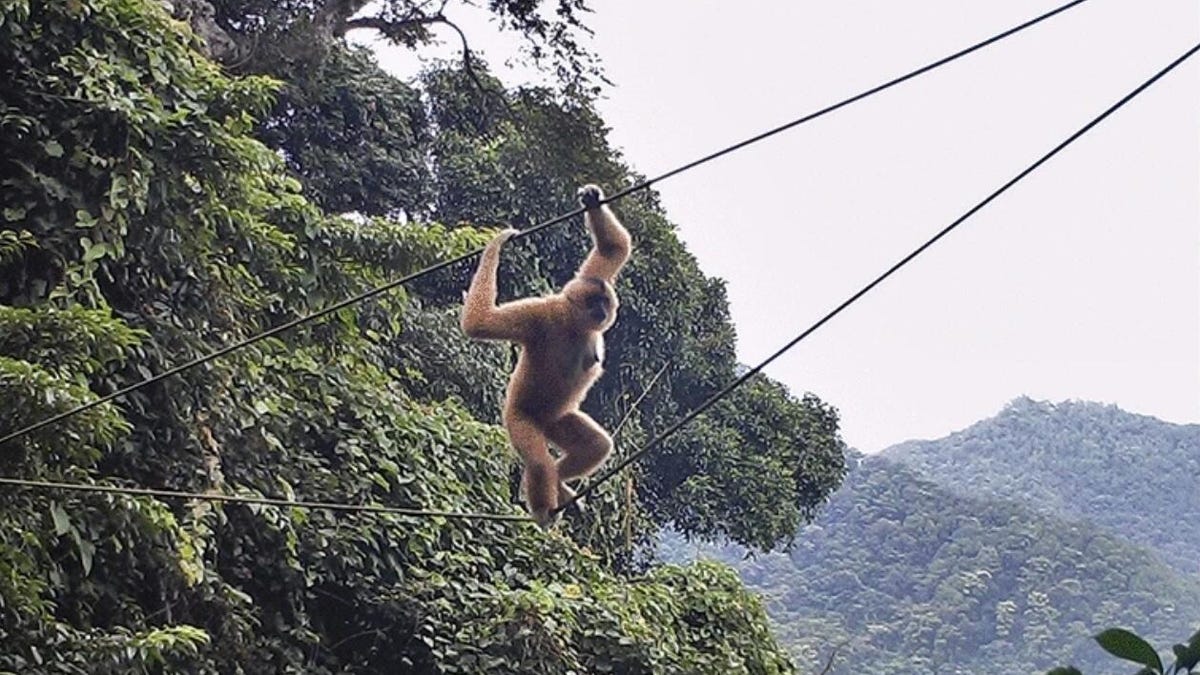The rarest primate on Earth is in danger. A rope bridge could help it survive
The Hainan gibbon faces a high threat of extinction, and conservationists want to reverse the trajectory.

In a nature reserve in China, wild gibbons have been swinging and climbing their way across a rope bridge. It seems like a pastime any primate would embrace. But the bridge isn't there for ape amusement. It's there to help a critically endangered species survive.
The Hainan gibbon (Nomascus hainanus) faces a high threat of extinction due to habitat loss and hunting, with only about 30 of the animals alive today, according to the Kadoorie Farm and Botanic Garden, a Hong Kong conservation group that's spearheaded an effort to preserve the primates.
The group just published a study, in the journal Scientific Reports, detailing how the gibbons, considered the rarest primate on Earth, have reacted to the first artificial canopy bridge installed to help them traverse forest gaps that can impact their dispersal, foraging and even breeding opportunities. Deforestation, typhoons and landslides can all fragment forests, making it difficult for primates to navigate their environment like usual.
"While restoring natural forest corridors should be a priority conservation intervention, artificial canopy bridges may be a useful short-term solution," the authors write.
Conservationists installed the two-pronged 52-foot (16 meter) bridge in 2015, tying mountaineering-strength ropes to sturdy trees so the apes could pass at the site of a typhoon-induced landslide, and installing a camera to document use of the crossing in both directions.
The gibbons had difficulty crossing the area of the landslide using fronds and leaves. And while larger males were able to leap over widely spaced trees, that method proved risky for hesitant pregnant females or those carrying infants.
Once the simple canopy bridge was in place at the Hainan Bawangling National Nature Reserve, photographs showed it took the gibbons a little over six months to begin crossing it, gradually increasing its use in the following years. Adult females initiated half the crossings, and juveniles tackled the other half. Most gibbons got across by "handrailing" -- walking on one rope with hands holding the second rope as handrails, or climbing underneath the ropes legs first with all limbs.
At least one brazen beast walked it like a tightrope.
The ape version of Philippe Petit.
Various types of artificial crossings have helped wildlife traverse ruptured forest canopies before, but the study in Scientific Reports documents the first one constructed for the Hainan gibbon, a species endemic to China's Hainan Island and known for singing to mark territory, enhance bonding and attract mates.
"Over 2,000 individuals were estimated to live throughout the island in the 1950s, but due to rampant poaching and forest loss, the population declined sharply to less than 10 individuals in the 1970s" before a determined effort got the number up to 30, Kadoorie Farm and Botanic Garden says.
As of 2020, the Hainan is the only gibbon species assessed by the International Union for Conservation of Nature Red List of Threatened Species to have a stable population, according to Kadoorie, adding "all 19 other species are decreasing in numbers."
The researchers consider the canopy bridge, while promising, a temporary solution. After constructing it, Kadoorie launched a reforestation project at the site of the landslide.

